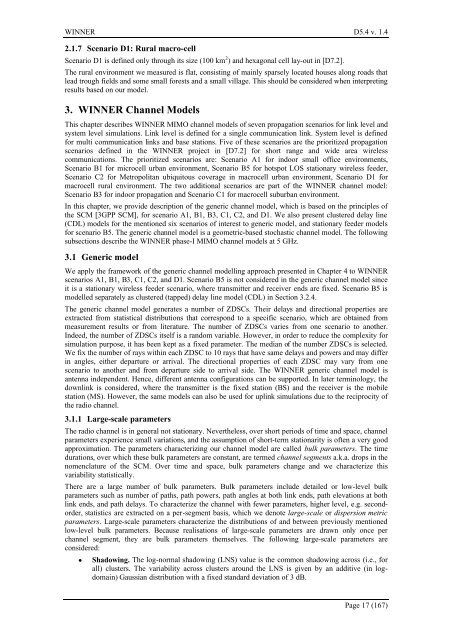Final report on link level and system level channel models - Winner
Final report on link level and system level channel models - Winner
Final report on link level and system level channel models - Winner
You also want an ePaper? Increase the reach of your titles
YUMPU automatically turns print PDFs into web optimized ePapers that Google loves.
WINNER D5.4 v. 1.4<br />
2.1.7 Scenario D1: Rural macro-cell<br />
Scenario D1 is defined <strong>on</strong>ly through its size (100 km 2 ) <strong>and</strong> hexag<strong>on</strong>al cell lay-out in [D7.2].<br />
The rural envir<strong>on</strong>ment we measured is flat, c<strong>on</strong>sisting of mainly sparsely located houses al<strong>on</strong>g roads that<br />
lead trough fields <strong>and</strong> some small forests <strong>and</strong> a small village. This should be c<strong>on</strong>sidered when interpreting<br />
results based <strong>on</strong> our model.<br />
3. WINNER Channel Models<br />
This chapter describes WINNER MIMO <strong>channel</strong> <strong>models</strong> of seven propagati<strong>on</strong> scenarios for <strong>link</strong> <strong>level</strong> <strong>and</strong><br />
<strong>system</strong> <strong>level</strong> simulati<strong>on</strong>s. Link <strong>level</strong> is defined for a single communicati<strong>on</strong> <strong>link</strong>. System <strong>level</strong> is defined<br />
for multi communicati<strong>on</strong> <strong>link</strong>s <strong>and</strong> base stati<strong>on</strong>s. Five of these scenarios are the prioritized propagati<strong>on</strong><br />
scenarios defined in the WINNER project in [D7.2] for short range <strong>and</strong> wide area wireless<br />
communicati<strong>on</strong>s. The prioritized scenarios are: Scenario A1 for indoor small office envir<strong>on</strong>ments,<br />
Scenario B1 for microcell urban envir<strong>on</strong>ment, Scenario B5 for hotspot LOS stati<strong>on</strong>ary wireless feeder,<br />
Scenario C2 for Metropolitan ubiquitous coverage in macrocell urban envir<strong>on</strong>ment, Scenario D1 for<br />
macrocell rural envir<strong>on</strong>ment. The two additi<strong>on</strong>al scenarios are part of the WINNER <strong>channel</strong> model:<br />
Scenario B3 for indoor propagati<strong>on</strong> <strong>and</strong> Scenario C1 for macrocell suburban envir<strong>on</strong>ment.<br />
In this chapter, we provide descripti<strong>on</strong> of the generic <strong>channel</strong> model, which is based <strong>on</strong> the principles of<br />
the SCM [3GPP SCM], for scenario A1, B1, B3, C1, C2, <strong>and</strong> D1. We also present clustered delay line<br />
(CDL) <strong>models</strong> for the menti<strong>on</strong>ed six scenarios of interest to generic model, <strong>and</strong> stati<strong>on</strong>ary feeder <strong>models</strong><br />
for scenario B5. The generic <strong>channel</strong> model is a geometric-based stochastic <strong>channel</strong> model. The following<br />
subsecti<strong>on</strong>s describe the WINNER phase-I MIMO <strong>channel</strong> <strong>models</strong> at 5 GHz.<br />
3.1 Generic model<br />
We apply the framework of the generic <strong>channel</strong> modelling approach presented in Chapter 4 to WINNER<br />
scenarios A1, B1, B3, C1, C2, <strong>and</strong> D1. Scenario B5 is not c<strong>on</strong>sidered in the generic <strong>channel</strong> model since<br />
it is a stati<strong>on</strong>ary wireless feeder scenario, where transmitter <strong>and</strong> receiver ends are fixed. Scenario B5 is<br />
modelled separately as clustered (tapped) delay line model (CDL) in Secti<strong>on</strong> 3.2.4.<br />
The generic <strong>channel</strong> model generates a number of ZDSCs. Their delays <strong>and</strong> directi<strong>on</strong>al properties are<br />
extracted from statistical distributi<strong>on</strong>s that corresp<strong>on</strong>d to a specific scenario, which are obtained from<br />
measurement results or from literature. The number of ZDSCs varies from <strong>on</strong>e scenario to another.<br />
Indeed, the number of ZDSCs itself is a r<strong>and</strong>om variable. However, in order to reduce the complexity for<br />
simulati<strong>on</strong> purpose, it has been kept as a fixed parameter. The median of the number ZDSCs is selected.<br />
We fix the number of rays within each ZDSC to 10 rays that have same delays <strong>and</strong> powers <strong>and</strong> may differ<br />
in angles, either departure or arrival. The directi<strong>on</strong>al properties of each ZDSC may vary from <strong>on</strong>e<br />
scenario to another <strong>and</strong> from departure side to arrival side. The WINNER generic <strong>channel</strong> model is<br />
antenna independent. Hence, different antenna c<strong>on</strong>figurati<strong>on</strong>s can be supported. In later terminology, the<br />
down<strong>link</strong> is c<strong>on</strong>sidered, where the transmitter is the fixed stati<strong>on</strong> (BS) <strong>and</strong> the receiver is the mobile<br />
stati<strong>on</strong> (MS). However, the same <strong>models</strong> can also be used for up<strong>link</strong> simulati<strong>on</strong>s due to the reciprocity of<br />
the radio <strong>channel</strong>.<br />
3.1.1 Large-scale parameters<br />
The radio <strong>channel</strong> is in general not stati<strong>on</strong>ary. Nevertheless, over short periods of time <strong>and</strong> space, <strong>channel</strong><br />
parameters experience small variati<strong>on</strong>s, <strong>and</strong> the assumpti<strong>on</strong> of short-term stati<strong>on</strong>arity is often a very good<br />
approximati<strong>on</strong>. The parameters characterizing our <strong>channel</strong> model are called bulk parameters. The time<br />
durati<strong>on</strong>s, over which these bulk parameters are c<strong>on</strong>stant, are termed <strong>channel</strong> segments a.k.a. drops in the<br />
nomenclature of the SCM. Over time <strong>and</strong> space, bulk parameters change <strong>and</strong> we characterize this<br />
variability statistically.<br />
There are a large number of bulk parameters. Bulk parameters include detailed or low-<strong>level</strong> bulk<br />
parameters such as number of paths, path powers, path angles at both <strong>link</strong> ends, path elevati<strong>on</strong>s at both<br />
<strong>link</strong> ends, <strong>and</strong> path delays. To characterize the <strong>channel</strong> with fewer parameters, higher <strong>level</strong>, e.g. sec<strong>on</strong>dorder,<br />
statistics are extracted <strong>on</strong> a per-segment basis, which we denote large-scale or dispersi<strong>on</strong> metric<br />
parameters. Large-scale parameters characterize the distributi<strong>on</strong>s of <strong>and</strong> between previously menti<strong>on</strong>ed<br />
low-<strong>level</strong> bulk parameters. Because realisati<strong>on</strong>s of large-scale parameters are drawn <strong>on</strong>ly <strong>on</strong>ce per<br />
<strong>channel</strong> segment, they are bulk parameters themselves. The following large-scale parameters are<br />
c<strong>on</strong>sidered:<br />
• Shadowing. The log-normal shadowing (LNS) value is the comm<strong>on</strong> shadowing across (i.e., for<br />
all) clusters. The variability across clusters around the LNS is given by an additive (in logdomain)<br />
Gaussian distributi<strong>on</strong> with a fixed st<strong>and</strong>ard deviati<strong>on</strong> of 3 dB.<br />
Page 17 (167)

















